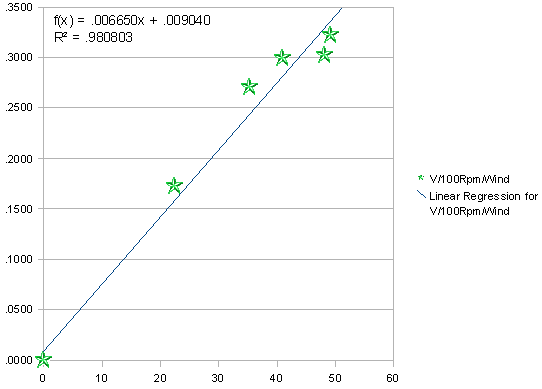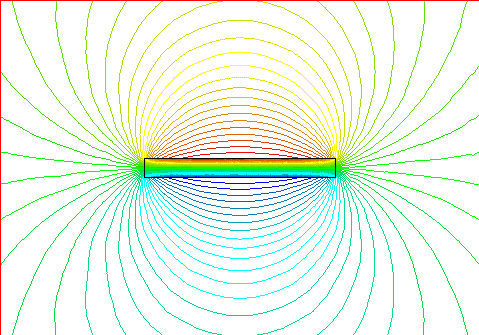Page 3 of 3
Re: Magnet strength

Posted:
Sun Jun 14, 2009 5:56 pmby windgat
I plotted some data I had (found a typing error on the Bench tests page in the process) and have some rather nice results. See graph...
It plots Grade x magnet volume vs volts per 100rpm per wind. All data is for three phase generator. Magnet volume in mm cubed, scaled down by a million. Should I assume crossing at the origin? Zero volume magnets surely equals zero volts, after all.
I know you say its not so simple, but it looks pretty close to being useful! it should allow me to predict, for a certain magnet grade and size, how many windings would be needed to get a certain voltage at a certain rpm. Perhaps factors like surface area are not sooo important because there is not a huge range of magnet sizes under consideration?
Sorry to hear about your health. Please stay strong - you are needed here!
Re: Magnet strength

Posted:
Mon Jun 15, 2009 8:29 amby Greystoke
I think this is VERY useful info

, and I DO think the line should go through zero. No sense (or justification) to assume otherwise.
I''ve approached this from the magnet side of things, trying to get a Gauss strength based on the grade and size(s) of the magnet. I'm trying to use Internet data for this, but I've found a lot of inconsistencies (and some of the dealers don't know what they're talking about

)
The next thing I did was to assume a "pass-over"-speed of 1m/s at 1mm height above a tight fitting coil and work out the emf = d?/dt.
I'll give you all the formulas if you like.
Re: Magnet strength

Posted:
Mon Jun 15, 2009 9:40 amby windgat
Ok, so here is one zero based. Next step is to get a spreadsheet set up whereby you can enter, e.g. magnet volume and grade, target voltage, and it will tell you how many turns are required. I tried this last night, quite unsuccessfully for some reason... perhaps I found it hard to concentrate because I kept being interrupted by having to go and refill my wine glass...

windsmagnets2.png
I have started on a 50 wind per coil stator, so that I can get more data to plot, and also to allow the more powerful magnets to work with smaller blades.
PS: I still don't know if magnet grade is zero based and/or linear... at the moment I am assuming both.
Re: Magnet strength

Posted:
Mon Jun 15, 2009 9:40 amby windgat
Ok, so here is one zero based. Next step is to get a spreadsheet set up whereby you can enter, e.g. magnet volume and grade, target voltage, and it will tell you how many turns are required. I tried this last night, quite unsuccessfully for some reason... perhaps I found it hard to concentrate because I kept being interrupted by having to go and refill my wine glass...


- windsmagnets2.png (6.31 KB) Viewed 11468 times
I have started on a 50 wind per coil stator, so that I can get more data to plot, and also to allow the more powerful magnets to work with smaller blades.
PS: I still don't know if magnet grade is zero based and/or linear... at the moment I am assuming both.
Re: Magnet strength

Posted:
Mon Jun 15, 2009 9:44 amby Greystoke
BTW:
This is what you get when you plot the Gauss strength of an assortment of rectangular magnets against their volume.
(Info obtained from: http://www.indigo.com/magnets/gphmgnts/Nd-rectangle-magnet-field-specifications.html)

Re: Magnet strength

Posted:
Mon Jun 15, 2009 10:12 amby windgat
Thanks for info. So what I need is some sort of a normalising factor? A very small magnet may have a strong field, but thats not helpful...
I work at the moment only with 50x20x8, 46x30x10 and 50x25x12.5mm magnets. Perhaps one could do something like assume they have the same surface area (facing the coils), and divide the volume by that? Would that help?
I am still in the dark about grade...
The most surpising thing to me is how close to linear the data I plotted is, without any adjusting/normalising!
Re: Magnet strength

Posted:
Mon Jun 15, 2009 10:13 amby windgat
Thanks for info. So what I need is some sort of a normalising factor? A very small magnet may have a strong field, but thats not helpful...
I work at the moment only with 50x20x8, 46x30x10 and 50x25x12.5mm magnets. Perhaps one could do something like assume they have the same surface area (facing the coils), and divide the volume by that? Would that help?
I am still in the dark about grade...
The most surpising thing to me is how close to linear the data I plotted is, without any adjusting/normalising!
Re: Magnet strength

Posted:
Mon Jun 15, 2009 12:44 pmby Greystoke
Just plotted the values for magnets with the same thickness, but different surface areas. Notice that there is a pronounced negative association.
Oh, and . . I actually work best after a few toots


Note: You can get the realtionship between 2.5 and 5mm thick magnets by dividing the two formulas into each other.
Re: Magnet strength

Posted:
Tue Jun 16, 2009 10:24 amby Greystoke
On the other hand . .
The lesser surface magents may be stronger close-up, but they lose out at the longer distances.

Re: Magnet strength

Posted:
Tue Jun 16, 2009 10:31 amby windgat
So using the zero crossing graph above, can you make some neat formulas to give winds from target V, RPM and magnet rating (Vol x grade), and also say to give RPM from winds, magnet rating, and V? (remember to have a few toots first!

)
Re: Magnet strength

Posted:
Fri Jul 31, 2009 10:03 pmby nvisser
Hi
Can anybody tell me if it is possible to use computer hard drive magnets. Some of them are quiet large and thick but they are magnetized in the lenght, meaning a different pole on each side if looking from above when it is lying flat?
Re: Magnet strength

Posted:
Sat Aug 01, 2009 7:27 amby Greystoke
I suppose you can - in principle - use ANY type of magnet, on condition that you can fit them properly to capture its magnetic flux with simple coils. However, . . .
You will not get the response likely to get from Neodymium magnets. They are far superior and will give you a lot more output. They also come in various shapes, sizes and orientation.
Frankly, I wouldn't consider anything else.
Re: Magnet strength

Posted:
Sat Aug 01, 2009 9:08 amby nvisser
Hard drive magnets are neodiniums and super strong and brittle
If I use them it means the the north pole will pass the top part of the coil the same time as the south pole pass the bottom part of the coil
I suppose I have to do a test and see on the scope what the signal looks like. I don`t think it will be a nice sine wave
Re: Magnet strength

Posted:
Sat Aug 01, 2009 10:04 amby KenFoyn
Good day to the boffins here,Here is my idea on how to compare magnetic strength between different magnets.
Using a strain gauge as is used in an electronic scale,but one that is used for pulling power,connecting a metal plate to it.
And putting a magnet onto the metal plate then putting a second plate onto the other side of the magnet. a bolt with a fine
thread is fitted to the second plate going through a jig with a nut,as the nut is tightened a reading of mass will increase until
the magnet come loose, at least then it will show which magnets are stronger and/or weaker.
You guys are boggling my mind with your formulas.
Re: Magnet strength

Posted:
Sat Aug 01, 2009 12:01 pmby Greystoke
Hi KenFoyn,
The formulas which windgat and I were trying to get, were meant to make life easier

. A pulling force is nice to separate the strong from the weak, but it gives no information about the magnetic flux inside the coils when the magnets fly past the coils at ±2mm distance.
You need that info to be able to predict the output voltage at different rpm's.
We are getting close though

Re: Magnet strength

Posted:
Sat Aug 01, 2009 12:08 pmby Greystoke
nvisser wrote:Hard drive magnets are neodiniums and super strong and brittle
If I use them it means the the north pole will pass the top part of the coil the same time as the south pole pass the bottom part of the coil
I suppose I have to do a test and see on the scope what the signal looks like. I don`t think it will be a nice sine wave
I didn't know that hard drive magnets are neodymiums. (Learned something new
!)
I suppose You could turn the orientation of the coils in order to capture the maximum flux. (maybe 90°to the magnet
?)

Re: Magnet strength

Posted:
Sat Aug 01, 2009 12:57 pmby windgat
Welcome to KenFoyn and nvisser!
You really do want the flat sides magnetised as the poles. Mechanically awkward otherwise.
I tried the hard drive magnet approach, but found you would need a LOT of hard drives to get anywhere, and it took a long time to extract the magnets, which often broke in the process. And then you have the magnetisation direction problem - all in all a lot of hassle.
Re: Magnet strength

Posted:
Mon Aug 03, 2009 11:17 amby PaulBurger
Hi windgat - can you bring a couple of your magnets to the course1 meeting again tomorrow?
I have made a gauss meter using a Hall Effect sensor and would like to see the comparison strength between the different magnets.
Especially as related to a hard drive magnet. (of which I have quite a bunch)
The meter can give a good comparative guide but not an exact measure of gauss as, with strong magnets, I have to hold the sensor a short distance away from the magent as it saturates the sensor. If I have the gauss values fo different magnets, I could calibrate it - I think.
Re: Magnet strength

Posted:
Mon Aug 03, 2009 11:50 amby windgat
Hi Paul, that sounds very interesting! I will do. I only have N35's at the moment, but have just ordered 240 magnets of various sizes for the course, so when those arrive we can test them.
Re: Magnet strength

Posted:
Mon Aug 03, 2009 8:29 pmby nvisser
Hi all
I do have a lot of hard drive magnets and only use the big thick ones
I used a thin grider blade to cut them in half and that solved the problem . Now I have a north on the one flat side and the south on the other
If used as is, the wave cancels out and you get nearly no voltage.
Re: Magnet strength

Posted:
Tue Aug 04, 2009 9:32 amby windgat
Umm....

If you cut a magnet in half, you don't get a south half and a north half... Can you explain in more detail what result you got? And maybe do some measuring to verify where the pole is...
Re: Magnet strength

Posted:
Tue Aug 04, 2009 6:32 pmby nvisser
Here is a picture of one.
http://www.otherpower.com/otherpower_experiments_ammeter.html
When you look it the picture the northpole is on the right top half and the south on the left top half
and directly on the flatside underneath are the opposing poles
They are flat magnets and you have to use them that way. There are not much magnetism on the sides
On this page they try to use it. I see that it passes the coils in its lenghts. That is n,s-n,s-n,s etc
http://wondermagnet.com/other/gentest.html
Re: Magnet strength

Posted:
Wed Aug 05, 2009 11:09 amby windgat
Looks like a great idea!



